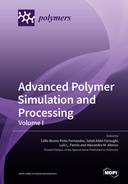Explore

Advanced Polymer Simulation and Processing
0 Ungluers have
Faved this Work
Login to Fave
Polymer-processing techniques are of the utmost importance for producing polymeric parts. They must produce parts with the desired qualities, which are usually related to mechanical performance, dimensional conformity, and appearance. Aiming to maximize the overall efficiency of the polymer-processing techniques, advanced modeling codes along with experimental measurements are needed to simulate and optimize the processes. Thus, this reprint exploits the digital transformation of the plastics industry, both through the creation of more robust and accurate modeling tools and the development of cutting-edge experimental techniques. Furthermore, it addresses advanced topics, such as crystallization during the solidification processes, prediction of fiber orientation in the cases of short and long fiber composites, prediction of the foaming process (such as microcellular foaming), and flow instabilities by including viscoelastic constitutive equations.
This book is included in DOAB.
Why read this book? Have your say.
You must be logged in to comment.
Rights Information
Are you the author or publisher of this work? If so, you can claim it as yours by registering as an Unglue.it rights holder.Downloads
This work has been downloaded 76 times via unglue.it ebook links.
- 76 - pdf (CC BY) at Unglue.it.
Keywords
- a family mold system
- ab initio molecular dynamics
- analytical solution
- anisotropy
- annocatacin B
- antimicrobial activity
- artificial engineering
- artificial neural networks (ANN)
- attenuation coefficient
- Au nanoparticles
- bacterial cellulose
- basic settings
- blown film extrusion
- boundary layer
- CAE
- CAE-DOE optimization
- calcium and magnesium removal
- Carbopol
- Cement
- CFD
- channel flow
- coat-hanger die
- Compound
- computer-aided engineering tools
- concentricity
- conformal cooling
- conformal cooling channel
- consistent PISO
- constant shear-rate die
- constitutive modeling
- continuous fiber-reinforced thermoplastics
- cooling medium
- crystallinity
- data-based
- deep learning
- degree of assembly
- dielectric function
- dilute polymeric solutions
- drag coefficient
- dynamic image analysis
- eccentric rotor extruder
- electrolyte
- elongational flow
- empirical derivation
- eXtended Pom-Pom
- extrudate swell
- extrusion
- FDM
- FEM
- fiber reinforced
- fiber reinforced polymer composites
- fiber shortening
- fillers
- Finite difference methods
- finite element analysis (fem)
- finite volume method
- flash differential scanning calorimeter
- flatness
- flax
- free-surfaces
- fully implicit coupled solver
- GEANT4 code
- Giesekus
- Giesekus fluid
- glass fiber
- gluing
- green channels
- heat pipe
- Hemp
- Herschel–Bulkley fluid
- Herschel–Bulkley fluids
- high energy pouch cell
- Hirshfeld charges
- History of engineering & technology
- hybrid injection molding
- hydraulic fracturing
- Hysteresis
- Industrial Design
- injection molding
- interface tracking
- iron sheet
- LDPE
- lead nanoparticles
- leakage flow
- least-squares volume-to-point interpolation
- Lime
- lithium-ion
- load position
- log-conformation tensor approach
- Machine learning
- magnetron sputtering
- manufacturing
- manufacturing process design
- MD
- melt blending
- melt filling
- meshless interpolation
- micro-polar fluids
- microfluidic rheometry
- micropolar fluids
- Microstructure
- mitochondrial respiratory complex I
- mixed polymers
- MM/PBSA
- Model
- modeling
- modeling and simulation
- mold additive manufacturing
- mold characterization
- mold heating
- mold material
- mold temperature control
- molding flow analysis
- molecular dynamics simulations
- Monte Carlo
- motor core
- MRC-I
- multi-layer structure
- Multilateral
- multilayer perceptron
- multiscale simulation
- n/a
- nanocomposite
- nanoporous matter
- ND1 subunit
- Neural Network
- non-isothermal crystallization
- non-isothermal effects
- non-newtonian fluids
- Numerical Simulation
- numerical solution
- Oldroyd-B fluid
- Oldroyd-B model
- OpenFOAM
- partial charge
- particle settling
- PEG-PCL
- Penetration
- Phan-Thien-Tanner constitutive equation
- pipe die
- pipe flow
- plasma treatment
- plasmonics
- plastic optical barrel
- plastic pallet
- plasticizing
- poly (3-hydroxybutyric-co-3-hydroxyvaleric acid) (PHBV)
- poly(ether ether ketone)
- poly(lactic acid)
- polyethylene recycling
- polymer blends
- polymer electrolyte membrane for fuel cell
- polymer extrusion
- polymer flows
- polymer matrix
- polymer melt
- polymer molds
- polymer processing
- polymer solution
- Polymers
- polypropylene
- pre-distribution
- prediction
- Properties
- Proton
- pyrolysis
- Quality
- rapid tooling
- rapid tooling technology
- régression
- RGD peptide (1FUV)
- rheology
- Rivlin–Sawyers equation
- rodlike particles
- roundness
- rubber compounds
- seawater
- semi-analytical method
- sequential valve gate system
- sheet die design
- shielding
- short fibers
- side chain
- SIGMA
- silver nanoparticles
- simulation
- slow-release fertilizer
- sodium carbonate
- solvent viscosity contribution
- sphere drag coefficient
- stacked learning
- state of charge
- Structure
- subtractive manufacturing
- suspension
- suspensions
- sustainability
- Taguchi
- Taguchi method
- tailings flocculation
- Technology, engineering, agriculture
- Technology: general issues
- temperature maps
- thermal annealing
- thermal homogenisation
- thermogravimetric analyzer (TGA)
- thermoplastic composites
- thermo–mechanical response
- thin wall injection molding
- thixotropy
- time-dependent viscoelastic property
- total bond order
- transfer learning
- transport behavior
- trapezoidal-loop shear
- triangular-loop shear
- urea
- vane extruder
- viscoelastic flow
- viscoelastic flows
- viscoelasticity
- Visualization
- warpage
- X-ray photoelectron spectroscopy
- yield stress
Links
DOI: 10.3390/books978-3-0365-6665-8Editions

